stack queue list容器
Posted 今天天气眞好
tags:
篇首语:本文由小常识网(cha138.com)小编为大家整理,主要介绍了stack queue list容器相关的知识,希望对你有一定的参考价值。
1. stack容器
1 stack 基本概念
概念:stack是一种先进后出(First In Last Out,FILO)的数据结构,它只有一个出口
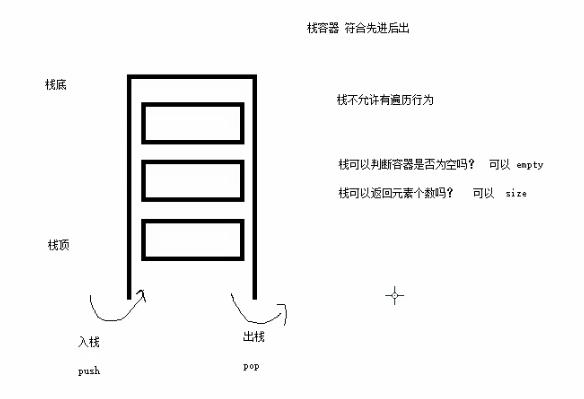
栈中只有顶端的元素才可以被外界使用,因此栈不允许有遍历行为
栈中进入数据称为 — 入栈 push
栈中弹出数据称为 — 出栈 pop
2 stack 常用接口
功能描述:栈容器常用的对外接口
构造函数:
stack<T> stk; //stack采用模板类实现, stack对象的默认构造形式
stack(const stack &stk); //拷贝构造函数
赋值操作:
stack& operator=(const stack &stk); //重载等号操作符
数据存取:
push(elem); //向栈顶添加元素
pop(); //从栈顶移除第一个元素
top(); //返回栈顶元素
大小操作:
empty(); //判断堆栈是否为空
size(); //返回栈的大小
示例:
#include <iostream>
using namespace std;
#include <stack>
void test()
{
stack<int> s;
s.push(10);
s.push(20);
s.push(30);
s.push(40);
while(!s.empty())
{
//输出栈顶元素
cout << "栈顶元素为: " << s.top() << endl;
//弹出栈顶元素
s.pop();
}
cout << "栈的大小为:" << s.size() << endl;
}
int main()
{
test();
return 0;
}
运行结果:
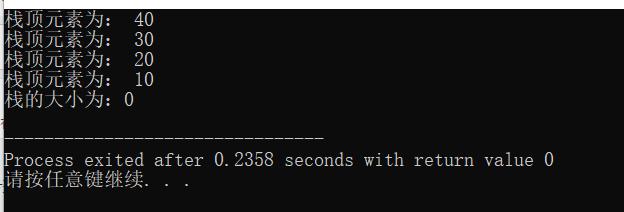
总结:
(1)入栈 — push
(2)出栈 — pop
(3)返回栈顶 — top
(4)判断栈是否为空 — empty
(5)返回栈大小 — size
2.queue 容器
1 queue 基本概念
概念:Queue是一种先进先出(First In First Out,FIFO)的数据结构,它有两个出口
队列容器允许从一端新增元素,从另一端移除元素
队列中只有队头和队尾才可以被外界使用,因此队列不允许有遍历行为
队列中进数据称为 — 入队 push
队列中出数据称为 — 出队 pop
2 queue 常用接口
功能描述:栈容器常用的对外接口
构造函数:
queue<T> que; //queue采用模板类实现,queue对象的默认构造形式
queue(const queue &que); //拷贝构造函数
赋值操作:
queue& operator=(const queue &que); //重载等号操作符
数据存取:
push(elem); //往队尾添加元素
pop(); //从队头移除第一个元素
back(); //返回最后一个元素
front(); //返回第一个元素
大小操作:
empty(); //判断堆栈是否为空
size(); //返回栈的大小
示例:
#include <iostream>
using namespace std;
#include <queue>
class Person
{
public:
Person(string name, int age)
{
this->m_Name = name;
this->m_Age = age;
}
string m_Name;
int m_Age;
};
void test()
{
//创建队列
queue<Person> q;
//准备数据
Person p1("唐僧", 30);
Person p2("孙悟空", 1000);
Person p3("猪八戒", 900);
Person p4("沙僧", 800);
//向队列中添加元素 入队操作
q.push(p1);
q.push(p2);
q.push(p3);
q.push(p4);
//队列不提供迭代器,更不支持随机访问
while (!q.empty()) {
//输出队头元素
cout << "队头元素-- 姓名: " << q.front().m_Name
<< " 年龄: "<< q.front().m_Age << endl;
cout << "队尾元素-- 姓名: " << q.back().m_Name
<< " 年龄: " << q.back().m_Age << endl;
cout << endl;
//弹出队头元素
q.pop();
}
cout << "队列大小为:" << q.size() << endl;
}
int main()
{
test();
return 0;
}
运行结果:
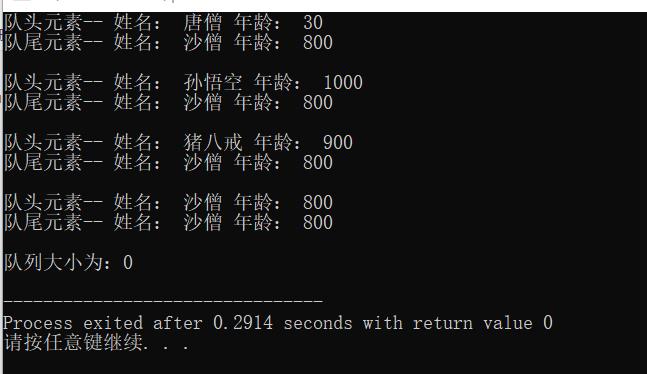
总结:
(1)入队 — push
(2)出队 — pop
(3)返回队头元素 — front
(4)返回队尾元素 — back
(5)判断队是否为空 — empty
(6)返回队列大小 — size
3.list容器
1 list基本概念
功能:将数据进行链式存储
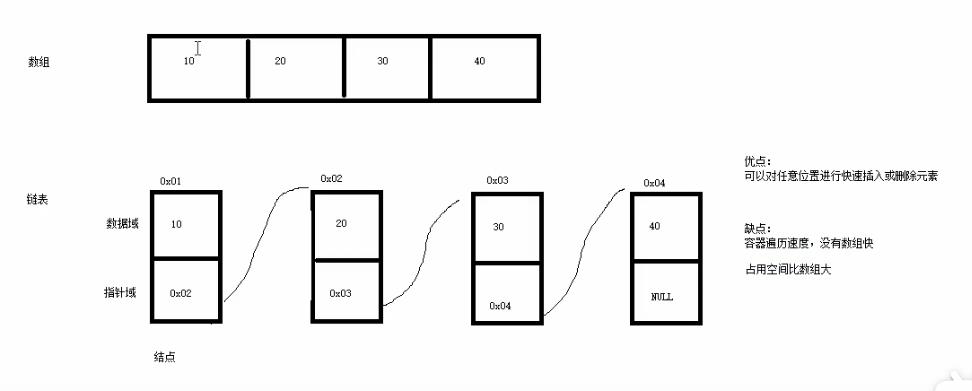
链表(list)是一种物理存储单元上非连续的存储结构,数据元素的逻辑顺序是通过链表中的指针链接实现的
链表的组成:链表由一系列结点组成
结点的组成:一个是存储数据元素的数据域,另一个是存储下一个结点地址的指针域
STL中的链表是一个双向循环链表
由于链表的存储方式并不是连续的内存空间,因此链表list中的迭代器只支持前移和后移,属于双向迭代器
list的优点:
采用动态存储分配,不会造成内存浪费和溢出
链表执行插入和删除操作十分方便,修改指针即可,不需要移动大量元素
list的缺点:
链表灵活,但是空间(指针域) 和 时间(遍历)额外耗费较大
List有一个重要的性质,插入操作和删除操作都不会造成原有list迭代器的失效,这在vector是不成立的。
总结:STL中List和vector是两个最常被使用的容器,各有优缺点
2 list构造函数
功能描述:
创建list容器
函数原型:
list<T> lst; //list采用采用模板类实现,对象的默认构造形式:
list(beg,end); //构造函数将[beg, end)区间中的元素拷贝给本身。
list(n,elem); //构造函数将n个elem拷贝给本身。
list(const list &lst); //拷贝构造函数。
示例:
#include <iostream>
using namespace std;
#include <list>
void printList(list<int> &l)
{
for(list<int>::iterator t = l.begin(); t != l.end(); t++)
{
cout << *t << " ";
}
cout << endl;
}
void test()
{
list<int> l;
l.push_back(10);
l.push_back(20);
l.push_back(30);
l.push_back(40);
printList(l);
list<int> l1(l.begin(),l.end());
printList(l1);
list<int> l2(4,2);
printList(l2);
list<int> l3(l2);
printList(l3);
}
int main()
{
test();
return 0;
}
运行结果:

总结:list构造方式同其他几个STL常用容器,熟练掌握即可
3 list 赋值和交换
功能描述:
给list容器进行赋值,以及交换list容器
函数原型:
assign(beg, end); //将[beg, end)区间中的数据拷贝赋值给本身。
assign(n, elem); //将n个elem拷贝赋值给本身。
list& operator=(const list &lst); //重载等号操作符
swap(lst); //将lst与本身的元素互换。
示例:
#include <iostream>
using namespace std;
#include <list>
void printList(list<int> &l)
{
for(list<int>::iterator t = l.begin(); t != l.end(); t++)
{
cout << *t << " ";
}
cout << endl;
}
void test()
{
list<int> l;
l.push_back(10);
l.push_back(20);
l.push_back(30);
l.push_back(40);
printList(l);
list<int> l1;
l1.assign(l.begin(),l.end());
printList(l1);
list<int> l2;
l2.assign(4,2);
printList(l2);
list<int> l3;
l3 = l2;
printList(l3);
cout << "交换前: " << endl;
printList(l1);
printList(l3);
l1.swap(l3);
cout << "交换后: " << endl;
printList(l1);
printList(l3);
}
int main()
{
test();
return 0;
}
运行结果:

4 list 大小操作
功能描述:
对list容器的大小进行操作
函数原型:
size(); //返回容器中元素的个数
empty(); //判断容器是否为空
resize(num); //重新指定容器的长度为num,若容器变长,则以默认值填充新位置。
//如果容器变短,则末尾超出容器长度的元素被删除。
resize(num, elem); //重新指定容器的长度为num,若容器变长,则以elem值填充新位置。
//如果容器变短,则末尾超出容器长度的元素被删除。
示例:
#include <iostream>
using namespace std;
#include <list>
void printList(const list<int>& L) {
for (list<int>::const_iterator it = L.begin(); it != L.end(); it++) {
cout << *it << " ";
}
cout << endl;
}
//大小操作
void test01()
{
list<int>L1;
L1.push_back(10);
L1.push_back(20);
L1.push_back(30);
L1.push_back(40);
if (L1.empty())
{
cout << "L1为空" << endl;
}
else
{
cout << "L1不为空" << endl;
cout << "L1的大小为: " << L1.size() << endl;
}
//重新指定大小
L1.resize(10);
printList(L1);
L1.resize(2);
printList(L1);
}
int main() {
test01();
system("pause");
return 0;
}
运行结果:
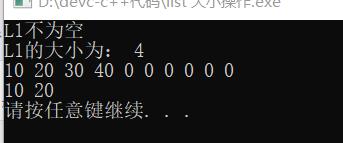
总结:
(1)判断是否为空 — empty
(2)返回元素个数 — size
(3)重新指定个数 — resize
5 list 插入和删除
功能描述:
对list容器进行数据的插入和删除
函数原型:
push_back(elem);//在容器尾部加入一个元素
pop_back();//删除容器中最后一个元素
push_front(elem);//在容器开头插入一个元素
pop_front();//从容器开头移除第一个元素
insert(pos,elem);//在pos位置插elem元素的拷贝,返回新数据的位置。
insert(pos,n,elem);//在pos位置插入n个elem数据,无返回值。
insert(pos,beg,end);//在pos位置插入[beg,end)区间的数据,无返回值。
clear();//移除容器的所有数据
erase(beg,end);//删除[beg,end)区间的数据,返回下一个数据的位置。
erase(pos);//删除pos位置的数据,返回下一个数据的位置。
remove(elem);//删除容器中所有与elem值匹配的元素。
示例:
#include <iostream>
using namespace std;
#include <list>
void printList(const list<int>& L) {
for (list<int>::const_iterator it = L.begin(); it != L.end(); it++) {
cout << *it << " ";
}
cout << endl;
}
//插入和删除
void test01()
{
list<int> L;
//尾插
L.push_back(10);
L.push_back(20);
L.push_back(30);
//头插
L.push_front(100);
L.push_front(200);
L.push_front(300);
printList(L);
//尾删
L.pop_back();
printList(L);
//头删
L.pop_front();
printList(L);
//插入
list<int>::iterator it = L.begin();
L.insert(++it, 1000);
printList(L);
//删除
it = L.begin();
L.erase(++it);
printList(L);
//移除
L.push_back(10000);
L.push_back(10000);
L.push_back(10000);
printList(L);
L.remove(10000);
printList(L);
//清空
L.clear();
printList(L);
}
int main() {
test01();
system("pause");
return 0;
}
运行结果:
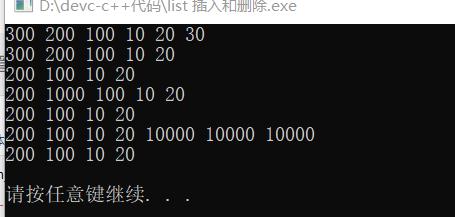
总结:
(1)尾插 — push_back
(2)尾删 — pop_back
(3)头插 — push_front
(4)头删 — pop_front
(5)插入 — insert
(6)删除 — erase
(7)移除 — remove
(8)清空 — clear
6 list 数据存取
功能描述:
对list容器中数据进行存取
函数原型:
front(); //返回第一个元素。
back(); //返回最后一个元素。
示例:
#include <iostream>
using namespace std;
#include <list>
//数据存取
void test01()
{
list<int>L1;
L1.push_back(10);
L1.push_back(20);
L1.push_back(30);
L1.push_back(40);
//cout << L1.at(0) << endl;//错误 不支持at访问数据
//cout << L1[0] << endl; //错误 不支持[]方式访问数据
cout << "第一个元素为: " << L1.front() << endl;
cout << "最后一个元素为: " << L1.back() << endl;
//list容器的迭代器是双向迭代器,不支持随机访问
list<int>::iterator it = L1.begin();
//it = it + 1;//错误,不可以跳跃访问,即使是+1
}
int main() {
test01();
system("pause");
return 0;
}
运行结果:
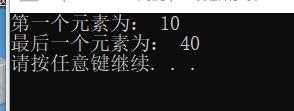
总结:
(1)list容器中不可以通过[]或者at方式访问数据
(2)返回第一个元素 — front
(3)返回最后一个元素 — back
7 list 反转和排序
功能描述:
将容器中的元素反转,以及将容器中的数据进行排序
函数原型:
reverse(); //反转链表
sort(); //链表排序
示例:
#include <iostream>
using namespace std;
#include <list>
void printList(const list<int>& L) {
for (list<int>::const_iterator it = L.begin(); it != L.end(); it++) {
cout << *it << " ";
}
cout << endl;
}
bool myCompare(int val1 , int val2)
{
return val1 > val2;
}
//反转和排序
void test01()
{
list<int> L;
L.push_back(90);
L.push_back(30);
L.push_back(20);
L.push_back(70);
printList(L);
//反转容器的元素
L.reverse();
printList(L);
//排序
L.sort(); //默认的排序规则 从小到大
printList(L);
L.sort(myCompare); //指定规则,从大到小
printList(L);
}
int main() {
test01();
system("pause");
return 0;
}
运行结果:
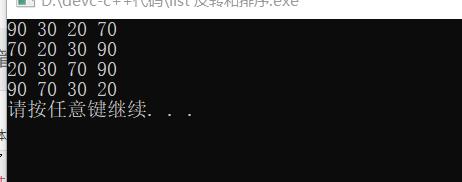
总结:
(1)反转 — reverse
(2)排序 — sort (成员函数)
8 排序案例
案例描述:将Person自定义数据类型进行排序,Person中属性有姓名、年龄、身高
排序规则:按照年龄进行升序,如果年龄相同按照身高进行降序
实例:
#include <iostream>
using namespace std;
#include <list>
class Person{
public:
Person(string name,int age,int height)
{
this->m_Name = name;
this->m_Age = age;
this->m_Height = height;
}
string m_Name;
int m_Age;
int m_Height;
};
bool ComparePerson(Person& p1, Person& p2) {
if (p1.m_Age == p2.m_Age) {
return p1.m_Height > p2.m_Height;
}
else
{
return p1.m_Age < p2.m_Age;
}
}
void test01() {
list<Person> L;
Person p1("刘备", 35 , 175);
Person p2("曹操", 45 , 180);
Person p3("孙权", 40 , 170);
Person p4("赵云", 25 , 190);
Person p5("张飞", 35 , 160);
Person p6("关羽", 35 , 200);
L.push_back(p1);
L.push_back(p2);
L.push_back(p3);
L.push_back(p4);
L.push_back(p5);
L.push_back(p6);
for (list<Person>::iterator it = L.begin(); it != L.end(); it++) {
cout << "姓名: " << it->m_Name << " 年龄: " << it->m_Age
<< " 身高: " << it->m_Height << endl;
}
cout << "---------------------------------" << endl;
L.sort(ComparePerson); //排序
for (list<Person>::iterator it = L.begin(); it != L.end(); it++) {
cout << "姓名: " << it->m_Name << " 年龄: " << it->m_Age
<< " 身高: " << it->m_Height << endl;
}
}
int main()
{
test01();
return 0;
}
运行结果:
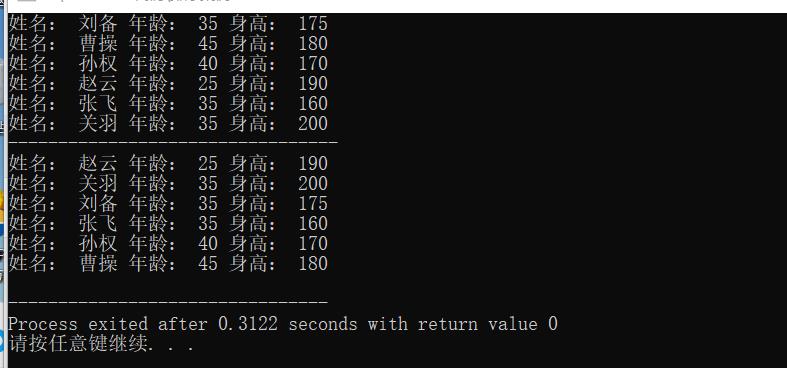
总结:
(1)对于自定义数据类型,必须要指定排序规则,否则编译器不知道如何进行排序
(2)高级排序只是在排序规则上再进行一次逻辑规则制定,并不复杂
以上是关于stack queue list容器的主要内容,如果未能解决你的问题,请参考以下文章